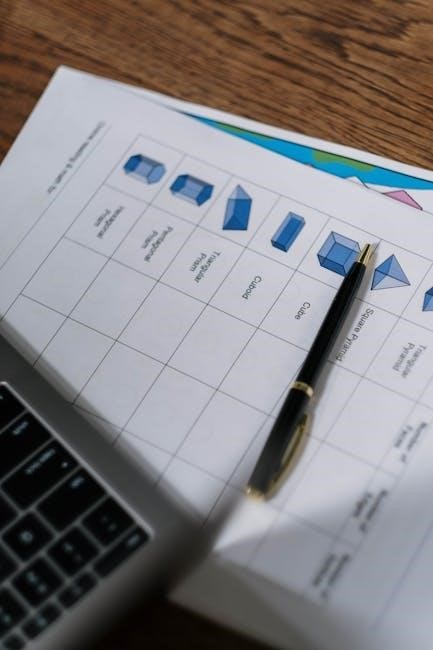Multiplication and division of integers are fundamental math operations. They involve positive and negative numbers, following specific rules for signs. Worksheets like Kuta Software’s and EffortlessMath’s provide practice problems, covering single and multi-digit operations, word problems, and mixed exercises. These resources help master integer operations, essential for real-world applications. Access worksheets here for comprehensive practice.
1.1 What Are Integers?
Integers are whole numbers that can be positive, negative, or zero. They include numbers like -5, 0, and 7. Integers are fundamental in mathematics, forming the basis for operations like multiplication and division. Understanding integers is crucial for solving problems in worksheets, where they are used to practice arithmetic skills. Positive integers are numbers greater than zero, while negative integers are less than zero. Zero serves as the starting point between positive and negative numbers. Grasping the concept of integers is essential for mastering higher-level math.
1.2 Importance of Mastering Integer Operations
Mastering multiplication and division of integers is vital for academic success and real-world problem-solving. These operations form the foundation for algebra, calculus, and higher-level mathematics. Worksheets are a proven method to develop proficiency. Regular practice with resources like worksheets helps build speed and accuracy. Understanding integer operations improves logical reasoning and analytical skills. It enhances the ability to solve word problems and apply math in everyday situations. Proficiency in integers also boosts confidence, making complex math problems more approachable. Investing time in these basics ensures a strong mathematical understanding for future challenges.

Understanding the Basics of Integer Multiplication
Integer multiplication involves multiplying positive and negative numbers. Rules include: positive × positive = positive, negative × negative = positive, and different signs yield a negative result. Worksheets like Kuta Software’s provide structured practice to master these concepts. Regular practice ensures fluency in applying these rules. Practice here to build a solid foundation.
2.1 Multiplying Positive Integers
Multiplying positive integers involves adding a number to itself a specified number of times. For example, 3 × 4 means adding 3 four times, resulting in 12. This process follows the commutative and associative properties, ensuring consistent results. Worksheets like Kuta Software’s provide structured exercises to practice these skills. Practice here to master positive integer multiplication. Regular practice helps build confidence and fluency in math operations. Start with single-digit problems and gradually move to multi-digit exercises for a comprehensive understanding. This foundational skill is essential for advanced math concepts.
2.2 Multiplying Negative Integers
Multiplying negative integers follows a specific rule: the product of two negative numbers is positive. For example, (-3) × (-4) = 12. This rule applies consistently, ensuring predictable outcomes. Worksheets like Kuta Software’s and EffortlessMath’s provide exercises to practice this concept. Practice here to master negative integer multiplication. Understanding this rule is crucial for solving real-world problems and advancing in math. Regular practice builds confidence and fluency in handling negative numbers. Start with simple problems and gradually tackle more complex ones for a solid foundation. This skill is essential for higher-level math operations.
2.3 Rules for Multiplying Integers with Different Signs
When multiplying integers with different signs, the product is negative. For example, 8 × (-6) = -48. This rule ensures consistency across all such operations. Practice worksheets provide exercises to master this concept. Understanding this rule is vital for solving real-world problems involving negative outcomes, such as calculating debts or temperature drops. Regular practice with problems like (-9) × 5 = -45 or 6 × (-12) = -72 builds fluency. This skill is foundational for advanced math operations and everyday applications. Start with simple problems and gradually tackle more complex ones for a solid understanding.

Mastering Integer Division
Integer division involves dividing positive and negative numbers. When signs are the same, the result is positive; otherwise, it’s negative. Practice worksheets provide exercises to refine this skill. Regular practice with problems like 12 ÷ (-4) = -3 or (-36) ÷ 9 = -4 helps build fluency. This skill is essential for solving real-world problems involving negative outcomes, such as calculating debts or temperature drops. Start with simple problems and gradually tackle more complex ones for a solid understanding.
3.1 Dividing Positive Integers
Dividing positive integers is a straightforward process that involves splitting a number into equal parts. For example, 12 ÷ 4 = 3, meaning 4 groups of 3 make 12. Worksheets provide exercises like 24 ÷ 6 = 4 or 18 ÷ 3 = 6. These problems help build a strong foundation for more complex integer division. Regular practice with single and multi-digit problems ensures mastery of this skill. It’s important to focus on accuracy and understanding the concept of equal distribution. Start with simple problems and gradually move to more challenging ones to reinforce your understanding. This skill is essential for real-world applications like splitting bills or measuring ingredients. Keep practicing to build confidence and speed in your calculations.
3.2 Dividing Negative Integers
Dividing negative integers follows a simple rule: when both integers are negative, the result is positive. For example, (-15) ÷ (-3) equals 5. Worksheets, such as those from Kuta Software and EffortlessMath, provide numerous practice problems to master this concept. These exercises help students understand how to handle negative signs during division. Regular practice ensures that learners can apply the rules confidently. Start with simple problems like (-12) ÷ (-4) = 3 and gradually move to more complex scenarios. This approach helps build a strong foundation for dividing negative integers. Remember, consistent practice is key to mastering this skill and avoiding common errors. Use available worksheets for comprehensive practice.
3.3 Rules for Dividing Integers with Different Signs
When dividing integers with different signs, the result is always negative. For example, (-12) ÷ 4 equals -3, and 15 ÷ (-5) equals -3. This rule applies to all such divisions. Worksheets like those from Kuta Software and EffortlessMath provide practice problems to reinforce this concept. Start with simple problems, such as (-18) ÷ 6 = -3, and progress to more complex ones like (-24) ÷ (-8) = 3; These exercises help students master the rules and avoid common errors. Regular practice ensures confidence in handling integer division with mixed signs. Use available worksheets for comprehensive practice.

Practice Problems for Multiplication and Division of Integers
Workheets offer a variety of problems, such as single-digit multiplication (e.g., 8 × 6) and division (e.g., 18 ÷ 3); They also include multi-digit challenges like 45 × 12 or 84 ÷ 21. Mixed-sign problems, such as (-12) ÷ 4, help reinforce sign rules. Word problems, like calculating negative temperatures, apply concepts to real-life scenarios. These exercises build fluency and confidence in integer operations, ensuring mastery of multiplication and division. Access practice sheets here.
4.1 Single-Digit Multiplication Problems
Single-digit multiplication problems are foundational for building math skills. Worksheets like Kuta Software’s and EffortlessMath’s provide exercises such as 8 × 6, 9 × 5, and -10 × -6. These problems help students understand how to multiply positive and negative integers, following the rule that a negative times a negative yields a positive. Mixed-sign problems, like 7 × -8, reinforce the concept that the result should be negative. Single-digit exercises simplify the learning process, allowing students to focus on sign rules and basic multiplication facts. Regular practice with these problems ensures mastery of integer multiplication fundamentals. Practice now.
4.2 Multi-Digit Multiplication Problems
Multi-digit multiplication problems challenge students to apply their skills to larger numbers. Worksheets often include exercises like 12 × 36, 9 × 63, and -6 × 12. These problems require multiplying each digit and adding the results. For negative numbers, the same rules apply: negatives multiplied together yield positives, while mixed signs result in negatives. Practice with multi-digit problems helps build accuracy and speed. Resources like Kuta Software and EffortlessMath provide comprehensive exercises, ensuring students can handle complex integer multiplication confidently. Regular practice with these problems strengthens understanding and prepares students for real-world applications. Download worksheets for more practice.
4.3 Single-Digit Division Problems
Single-digit division problems are foundational for mastering integer division. Worksheets feature exercises like 12 ÷ 3, 36 ÷ 9, and 85 ÷ 17, ensuring students understand how to divide both positive and negative numbers. The rules for signs apply: positive divided by positive yields positive, while mixed signs result in negative answers. These problems help build fluency in division and understanding of remainders. Resources such as Kuta Software and EffortlessMath provide numerous exercises to practice single-digit division, reinforcing key concepts. Regular practice helps students grasp the relationship between multiplication and division, essential for solving more complex problems. Access division practice sheets here for further learning.
4.4 Multi-Digit Division Problems
Multi-digit division problems challenge students to apply their understanding of integer division to more complex scenarios. Worksheets often include problems like 180 ÷ 15 or 128 ÷ 16, requiring careful calculation. When dividing negative integers, the rules for signs must be applied: a negative divided by a negative yields a positive result, while mixed signs produce a negative answer. These exercises help students develop accuracy and speed in division. Resources like Kuta Software’s worksheets and EffortlessMath’s practice sheets offer a variety of multi-digit division problems, including word problems. Regular practice ensures mastery of dividing larger numbers and applying integer rules correctly. Access multi-digit division practice here for improved skills.

Real-World Applications of Integer Operations
Integer operations are essential in everyday life, such as budgeting, measuring ingredients, and calculating distances or speeds. They also aid in solving word problems involving mixed numbers and signs.
These skills are practical for real-world scenarios, making them indispensable for daily tasks and decision-making. Explore practical examples here for better understanding.
5.1 Using Multiplication and Division in Everyday Life
Multiplication and division of integers are crucial in daily activities. For instance, calculating distances, budgeting expenses, or adjusting recipe ingredients requires these operations.
Understanding how to handle positive and negative integers simplifies tasks like splitting bills or measuring temperatures.
For example, dividing 12 apples among 4 friends (12 ÷ 4 = 3) or calculating the cost of items on sale (-$5 discount) are practical applications.
These skills also apply to scaling recipes, where multiplying ingredients by a factor ensures consistency.
Visit this worksheet for practice problems that reflect real-world scenarios. Mastering these operations enhances problem-solving abilities in various life situations.
5.2 Solving Word Problems Involving Integers
Word problems involving integers require applying multiplication and division skills to real-life scenarios. For example, calculating the cost of items on sale (-$5 discount) or adjusting recipe ingredients (e.g., doubling a recipe using multiplication).
These problems often involve mixed operations and require determining the sign of the result.
Worksheets like those from Kuta Software and EffortlessMath provide practice with such scenarios, ensuring mastery of integer operations.
Solving these problems enhances critical thinking and problem-solving abilities.
Visit this resource for practical exercises to improve your skills in solving word problems with integers.

Common Errors and Misconceptions
Common mistakes include incorrect sign determination and misapplying multiplication/division rules. Practice with worksheets like Kuta Software’s helps avoid these errors. Practice here.
6.1 Mistakes in Determining the Sign of the Result
A common error is incorrectly determining the sign of the result when multiplying or dividing integers. Many students mistakenly believe that multiplying two negative numbers yields a negative result or that dividing a positive by a negative always gives a positive. To avoid this, it’s crucial to remember the rule: an even number of negatives results in a positive, while an odd number yields a negative. Worksheets from sources like Kuta Software and EffortlessMath provide targeted exercises to help students master sign rules. Regular practice with these materials can significantly reduce such errors.
6.2 Errors in Applying Multiplication and Division Rules
Common mistakes occur when applying multiplication and division rules for integers. Students often overlook the rules for negative signs, leading to incorrect results. For instance, multiplying a negative by a negative should yield a positive, but some forget this, resulting in errors. Similarly, dividing negatives incorrectly can lead to wrong signs. Worksheets from Kuta Software and EffortlessMath provide exercises to reinforce these rules. Practicing with these resources helps students avoid such errors and build confidence in their problem-solving skills. Regular review ensures mastery of these essential operations.
Mastering integer multiplication and division is crucial. Worksheets from Kuta Software and EffortlessMath offer comprehensive practice, ensuring a strong foundation. Access resources here regular practice.
7.1 Summary of Key Concepts

Multiplication and division of integers involve specific rules for positive and negative numbers. Key concepts include determining the sign of results, applying multiplication and division rules, and solving real-world problems. Worksheets like those from Kuta Software and EffortlessMath provide comprehensive practice, covering single-digit, multi-digit, and mixed-sign operations. They also include word problems and answer keys for self-checking. Regular practice with these resources helps build fluency and understanding. Access these worksheets to reinforce learning and mastery of integer operations.
7.2 Encouragement to Practice Regularly
Regular practice is essential for mastering multiplication and division of integers. Consistent effort helps build confidence and fluency in applying rules for positive and negative numbers. Worksheets like those from Kuta Software and EffortlessMath provide structured exercises to reinforce learning. Set daily goals to solve a few problems, focusing on understanding concepts rather than speed. Use answer keys to check progress and correct mistakes. Over time, regular practice will make integer operations second nature. Encourage learners to explore online tools and word problems for varied challenges. Persistence and dedication are key to excelling in these foundational math skills. Start practicing today and watch improvement unfold.

Additional Resources
Explore worksheets by Kuta Software and EffortlessMath for practice. These resources offer integer multiplication and division exercises with answers, perfect for skill mastery and quick reference.
8.1 Recommended Worksheets for Further Practice
For effective practice, consider worksheets from Kuta Software and EffortlessMath. These resources provide comprehensive exercises on integer multiplication and division, including single-digit, multi-digit, and mixed problems. They include answer keys for self-assessment. The worksheets are designed for various skill levels, making them suitable for both beginners and advanced learners. Regular practice with these materials helps reinforce understanding and improves problem-solving speed and accuracy. Additionally, they cover word problems, ensuring practical application of integer operations. Utilize these tools to strengthen your math foundation and build confidence in handling integers.
8.2 Online Tools for Learning Integer Operations
Enhance your learning with online tools like Corbettmaths, offering video tutorials and interactive exercises. Khan Academy and Mathway provide step-by-step solutions, while IXL and Coolmath offer engaging practice games. These platforms cover integer multiplication, division, and real-world applications, ensuring a well-rounded understanding. Utilize these resources to supplement your studies, track progress, and gain confidence in handling integers effectively. Regular use of these tools will help solidify your skills and prepare you for more advanced mathematical concepts. Explore these platforms to find the ones that best suit your learning style and needs.